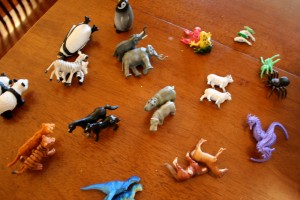
Let’s say you had to make a new Ark, a SPACE ARK, and a returned Elohim declared that you must reconstitute every species now living on Earth on a new home.
He might make it easier on us by using the old “two of every kind” algorithm. Then, we could more simply estimate what we needed, and the size of our Space Ark. Some of this work has already been done (probably not for that purpose). Here’s an estimate for the number of species on planet Earth: 8.7 million (with an error margin of 1.3 million). That comes from a “new analytical technique” published in 2011 by the Census of Marine Life (don’t worry, they estimated both land and sea life numbers.)
But what if we then were charged with replicating Earth once we arrived, jet-lagged and really sick of spotting inteplanetary license plates, at Earth 2.0? We’d need to breed our stock up to an Earthlike level of biomass. That means we might need to know, so as not to grossly imbalance our felines vs. our lepidoptera, for example, how many animals live on Earth. Not how many species — how many animals? More accurately, how many individual organisms? If you took a head count? Heads on tables, you creepy crawlies, and one hand up.
That’s tougher. I wanted to find a ballpark figure for that number when I was writing yesterday’s post about the dinosaur die-off — basically, I was curious about how many individual dinosaurs lived at any one time (before the mass extinction). So, I thought I’d look into how many animals exist today…and there’s not much on it (that I could find). Here’s an essay from 2009 attempting to estimate how many wild animals roam the planet.
Drawing from various sources, the author lists numbers of, for example, mammals of 10^11 to 10^12 — so on the order of 10 trillion. Land birds (i.e., the remaining dinosaurs) come in a bit lower, at up to 4 trillion. The number of animals, then, if these numbers are at least ballpark believable, will likely stick to the trillions. Tens of trillions, maybe. Possibly up to the 100s of trillions.
The real heavy-hitters come with the insects, at up to 10^19 — or (if I’m counting zeros correctly) 100 quintillion (!!) — the zooplankton, at up to 10 sextillion, and the nematodes, coming in at up to 100 sextillion.
So, in other words, the head count of individual organisms on Space Ark Earth is a lot simpler if you just say, “Several sextillion microorganisms…plus an order of magnitude less insects…and odds and ends of other stuff.” Mammals, numbering merely in the trillions, amount to a millionth, at best, of the insect crowd, and a billionth of the nematodes.
So, how many animals are there on Earth? Doesn’t matter. Focus on the nematodes, Space Noah.